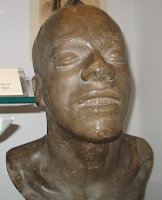



William Corder (1803-1828) was convicted and executed for Suffolk, England's infamous Murder in the Red Barn. The judge passed sentence as follows:
Nothing remains now for me to do but to pass upon you the awful sentence of the law, and that sentence is - That you be taken back to the prison from whence you came, and that you be taken from thence, on Monday next, to a place of Execution, and that you there be hanged by the Neck until you are Dead ; and that your body shall afterwards be dissected and anatomized ; and may the Lord God Almighty, of his infinite goodness, have mercy on your soul!So my first solid stab at researching public dissection is to look further into this case. I had studied it from another angle during graduate school, because in addition to Corder's body being anatomized, his skin was tanned and used to bind a transcript of his trial. Pictured above--along with a portrait, his death mask, and an illustration of his hanging--it can still be seen today. It was one of the many anthropodermic bindings I wrote and made presentations about. Another, which I had a look at when I was in Boston, is The Highwayman.









No comments:
Post a Comment
You may add your comments here.